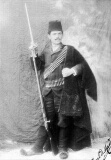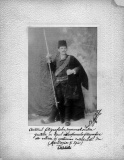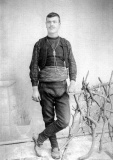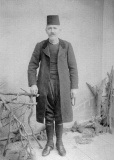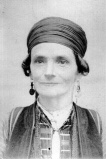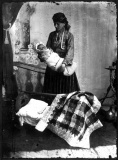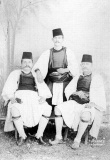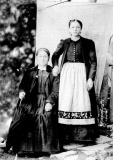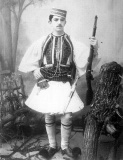Difference between revisions of "Yanaki and Milton Manaki"
(→Film) |
|||
| Line 25: | Line 25: | ||
==Film== | ==Film== | ||
| − | According to the memoirs of Milton Manaki, in 1905, his older brother traveled through several European capitals. In London he bought 35 mm Bioscope film camera with serial number 300 from the Charles Urban Trade Company. With this camera they shot the 60 seconds long documentary film of their 114-year-old grandmother Despina weaving in Avdella | + | According to the memoirs of Milton Manaki, in 1905, his older brother traveled through several European capitals. In London he bought 35 mm Bioscope film camera with serial number 300 from the Charles Urban Trade Company. With this camera they shot the 60 seconds long documentary film of their 114-year-old grandmother Despina weaving in Avdella regarded as the first motion picture shot in the Balkans. The film was made only 10 years after the shooting of the first Lumière brothers film, which influenced the brothers. Living in a time of transition from the 19th to 20th century, during the Ilinden Uprising, the Balkan Wars and the First World War, the development of Bitola as a consulate and military center of the Ottoman Empire, the brothers Manaki with their films helped to perpetuate these historical events. |
Yanaki and Milton recorded a number of films, mostly documentaries that were talking about all aspects of life in the city of Bitola such as popular dances, religious rituals, weddings, and funerals. | Yanaki and Milton recorded a number of films, mostly documentaries that were talking about all aspects of life in the city of Bitola such as popular dances, religious rituals, weddings, and funerals. | ||
Revision as of 20:56, 9 April 2014
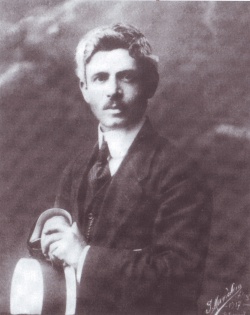 Photo of Ienache Manakia, 1917. | |
| Born |
May 18, 1878 Avdella, Ottoman Empire (today northern Greece) |
|---|---|
| Died |
May 19, 1954 (aged 76) Thessaloniki, Greece |
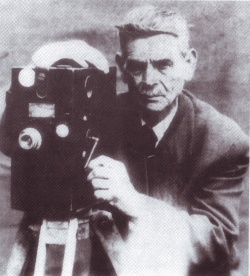 Milton Manakia in a scene from the movie Camera 300. | |
| Born |
May 18, 1878 Avdella, Ottoman Empire (today northern Greece) |
|---|---|
| Died |
May 19, 1954 (aged 76) Bitola, Yugoslavia |
The brothers Ianachia (Ion, Ionel, Ianakis, Ianaki sau Iovan, Yanaki, 1878–1954) and Milton Manachia (Miltiade, Maltu, 1882–1964) were photography and cinema pioneers who gained reputation for bringing the first film camera and creating the first motion pictures on the Balkan Peninsula and the Ottoman Empire. Their work was done in the city of Bitola, a strong economical and cultural center in Ottoman Rumelia.
Contents
Photography
Yanaki was employed as an art teacher in a Romanian school in Ioannina. Here he opened his first photographic studio in 1898 where he asked his brother to go along and learn photography.
In 1903 they photographed a popular uprising for the newspaper Universul [1]. In 1904 the two moved from their birthplace Avdella to the town Manastir (present-day Bitola). One year after, they open their own atelier for photographic art. After their excellent work is seen by the Balkan public, in 1906 they get an invitation from the king Carol I of Romania to participate in the World Photo Exhibition in Sinaia, Romania, where they won a gold medal for their collection. Later, they become the official photographers of the Ottoman Sultan, and in 1929 to the King of Yugoslavia Alexander Karađorđević.
Film
According to the memoirs of Milton Manaki, in 1905, his older brother traveled through several European capitals. In London he bought 35 mm Bioscope film camera with serial number 300 from the Charles Urban Trade Company. With this camera they shot the 60 seconds long documentary film of their 114-year-old grandmother Despina weaving in Avdella regarded as the first motion picture shot in the Balkans. The film was made only 10 years after the shooting of the first Lumière brothers film, which influenced the brothers. Living in a time of transition from the 19th to 20th century, during the Ilinden Uprising, the Balkan Wars and the First World War, the development of Bitola as a consulate and military center of the Ottoman Empire, the brothers Manaki with their films helped to perpetuate these historical events.
Yanaki and Milton recorded a number of films, mostly documentaries that were talking about all aspects of life in the city of Bitola such as popular dances, religious rituals, weddings, and funerals.
The brothers also pioneered the longer newsreel film by recording the visits of Sultan Mehmed Rashid V to Salonika and Bitola in 1911. [2]
Apart from their activity in filmmaking and photography, in 1921 they built an outdoor cinema named "Manaki", under the open sky on the main street Shirok Sokak. However this temporary solution does not satisfy the two brothers, so they built a movie theater, which began its work on the 1st of December 1923. Unfortunately, this historic building was destroyed in 1939 in a fire.
Legacy
Today at the National Archive of the Republic of Macedonia are preserved more than 17.000 photos made in 120 locations and over 2000 meters recorded film frоm the brothers Manaki. They left a rich legacy of important documentary value of the historical and cultural development of Eastern Europe. In their honor the Manaki Brothers Film Festival is held every year.
In honor of their work, the International Cinematographers' Film Festival "Manaki Brothers" (founded in 1979 and renamed to "Manaki Brothers" in 1993) is held every year in Bitola. The film award is named "Room 300" [Camera 300].
Gallery
Filmography
Documentary films about the brothers
- Room 300 [Camera 300], short film by the Croatian director Branko Ranitović, 1958.
- The Manakis brothers - the Balkan pioneers [Fratii Manakia - pionierii din Balcani], dir. Manuela Tanase, screenplay: Marian Ţuţui, 1995.
- The Manakis brothers [Fratii Manakia], dir. Sabina Pop, screenplay: Marian Ţuţui, 2002. Co-production of the national televisions of Macedonia, Albania and Romania.
See also
- Macedonia#Early cinema
- Albania# Early cinema
- Romania#Early cinema
- Greece#Early cinema
- Turkey#Early cinema
Literature
- Giorgis Exarchos, Αδελφοί Μανάκια: πρωτοπόροι του κινηματογράφου στα Βαλκάνια και το "Βλαχικόν ζήτημα", [The Brothers Manakia: Pioneers of the Cinema in the Balkans and the "Vlach Question"], Athens: Gavriilidis, 1991. (in Greek)
- Igor Stardelov, "Preservation of Manaki Brothers Film Heritage" , Journal of Film Preservation 26:54 (April 1997), pp 27-30.
- Marian Ţuţui, Orient Express: filmul românesc şi filmul balcanic sau Cinematograful balcanic, Bucharest: Editura Noi Media Print, 2008. (in Romanian)
- Marian Ţuţui, Fraţii Manakia şi imaginea Balcanilor, Bucharest: Editura Noi Media Print, 2009 (in Romanian).
- Goran Trenčovski, "A View Of The Macedonian Documentary Film".
